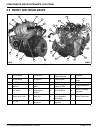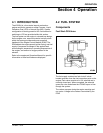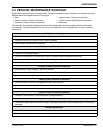
OPERATION
20 Operation TP-6901 6/14
— Check and clean cooling areas, air intake
areas, and external surfaces of the engine,
particularly if the engine has been stored for a
long period of time.
— Check to make sure that air cleaner
components, shrouds, equipment covers, and
guards are in place and securely fastened.
— Check all electrical connections to make sure
that they are tight, including those at the
alternator, starter, spark plug, and ignition coil.
Repair damaged or loose wires or connectors
before starting the engine.
— Check the fuel system. Make sure that all
connections are secure at the fuel supply line
and at all fuel system components. Do not
start the engine if you can smell leaking
gas.
— LPG only: check the fuel level in the fuel tank,
and refill if necessary.
4.4 STARTING
The specific engine starting sequence varies
depending on the equipment that this engine powers.
Refer to your Equipment Operation Manual for more
information.
If the engine does not start after 5 seconds of cranking,
wait at least 15 seconds before trying again. Do not
crank the starter longer than three crank cycles. After
three crank cycles, the controller will display faults.
Longer crank times can overheat the starter and drain
the battery.
If the engine does not start after three attempts,
discontinue the starting procedure. Perform
troubleshooting to locate the problem(s) and correct
them before trying again.
WARNING
!
Carbon monoxide can cause
severe nausea, fainting, or death.
Avoid inhaling exhaust fumes.
Engine exhaust gasses contain poisonous carbon
monoxide. Carbon monoxide is odorless,
colorless, and can cause death if inhaled.
WARNING
!
Rotating parts can cause severe
injury.
Stay away while the engine is in
operation.
Keep hands, feet, hair, and clothing away from all
moving parts to prevent injury. Never operate the
engine with covers, shrouds, or guards removed.
WARNING
!
Explosive fuel can cause fires and
severe burns.
If a gaseous odor is detected,
ventilate the area and contact an
authorized service technician.
LPG (Liquefied Petroleum Gas) is extremely
flammable and tends to settle in low areas where a
spark or flame could ignite the gas. Do not start or
operate this engine in a poorly ventilated area where
leaking gas could accumulate and endanger the safety
of persons in the area.
NG (Natural Gas) is extremely flammable, is lighter
than air, and rises. Do not start or operate this engine
in a poorly ventilated are where leaking gas could
accumulate and endanger the safety of persons in the
area.
To ensure personal safety, installation and repair of
LPG/NG fuel supply systems must be performed only
by qualified LPG/NG system technicians. Improperly
installed and maintained LPG/NG equipment could
cause the fuel supply system or other components to
malfunction, causing gas leaks.
Observe federal, state, and local laws governing
LPG/NG fuel, storage, and systems.


















